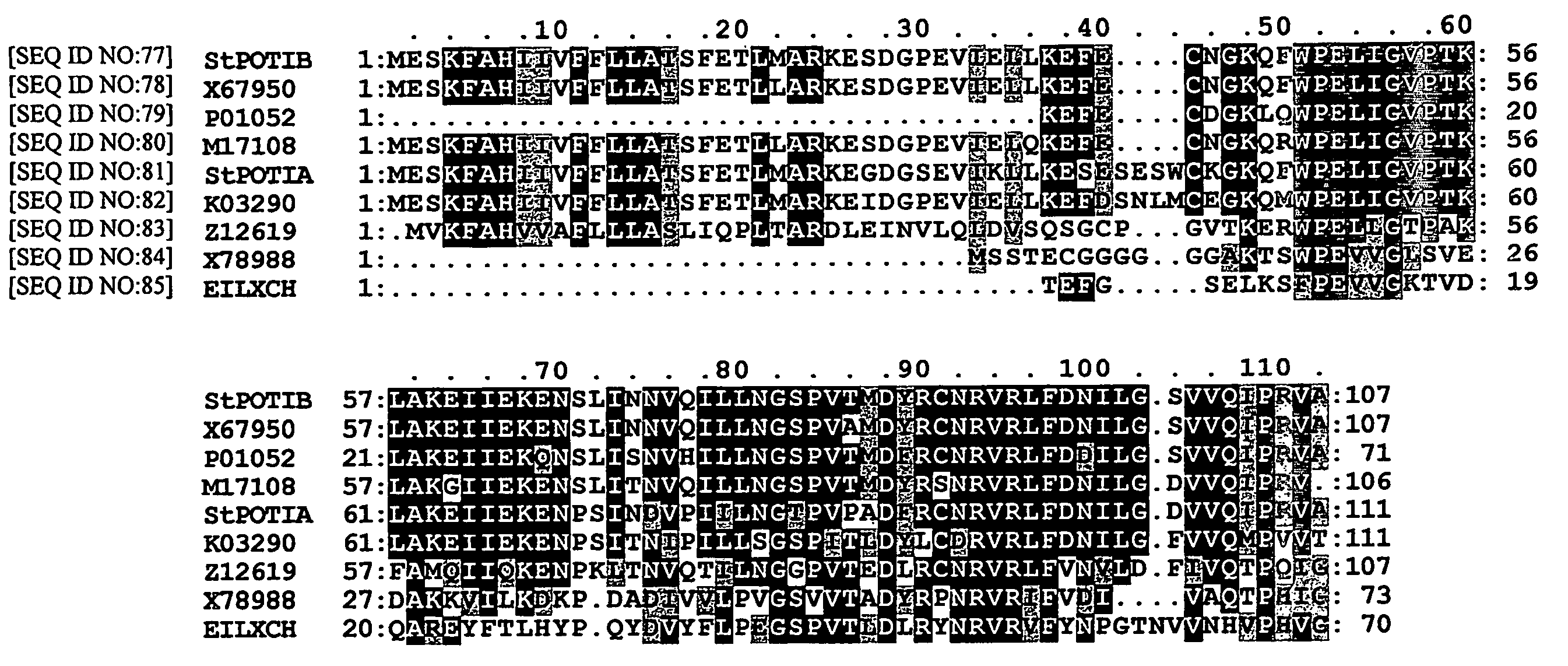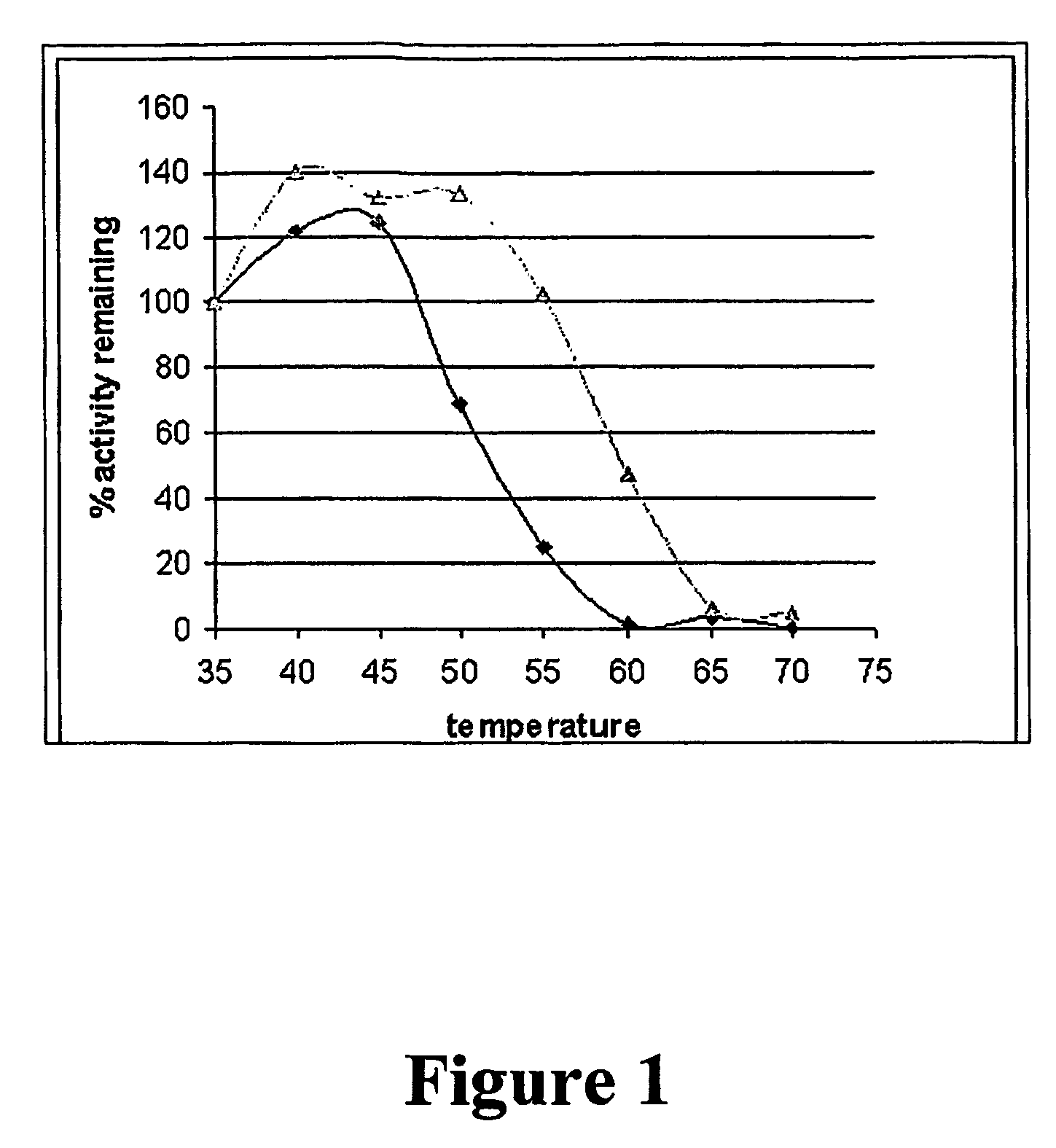Insect chymotrypsin and inhibitors thereof
a technology of insect chymotrypsin and inhibitors, which is applied in the field of insect chymotrypsin, can solve the problems of limited use of insect gut specific for only one or two of the range of proteinases for long-term plant protection, and is inability to identify structural changes
- Summary
- Abstract
- Description
- Claims
- Application Information
AI Technical Summary
Benefits of technology
Problems solved by technology
Method used
Image
Examples
example 1
Effect of Ingestion of the N. alata Proteinase Inhibitors on Growth and Development of Helicoverpa species
[0220]The effect of the N. alata PIs is examined on the digestive enzymes and the growth and development of Helicoverpa punctigera and Helicoverpa armigera larvae (Heath et al., J. Insect Physiol. 43: 833-842, 1997). The PIs suppressed total gut protease activity by 73% in an in vitro assay using 14C-casein as substrate. When incorporated into an artificial diet the PIs retarded the growth and development of both H. punctigera (Heath et al., 1997, supra) (FIGS. 2A and 2B) and H. armigera. Similar results are obtained when larvae from both species were fed on transgenic tobacco (N. tabacum) expressing the N. alata PIs at levels of 0.2% -0.5% soluble protein (Heath et al., 1997, supra).
[0221]Ingestion of NaPIs (C1, C2 and T1-T4) changes the relative activity of the trypsins and chymotrypsins in the gut and faeces of H. punctigera larvae. Trypsin activity in the gut and the faeces ...
example 2
Isolation of NAPI Sensitive and Insensitive Chymotrypsins from H. punctigera gut
[0235]Most published work on Helicoverpa chymotrypsins has focused on cDNA clones or the measurement of enzyme activity in unfractionated gut extracts. There are few reports on purification of chymotrypsins from Helicoverpa or other lepidopteran species. Johnston and coworkers (1995, supra) described partial purification of chymotrypsins from H.armigera that employed ion exchange techniques. Peterson and coworkers (Insect Biochem. Mol. Biol. 25: 765-774, 1995) purified a chymotrysin from the midgut of the lepidopteran Manduca sexta by affinity chromatography on tryptophan methyl ester and Valiatis et al., Insect Biochemistry and Molecular Biology 29: 405-415, 1999 used immobilized potato proteinase inhibitor I (PotI) to isolate a chymotrypsin from the Western Spruce budworm. No one has described a procedure that separates individual chymotrypsin isozymes from one another and there is no description of th...
example 3
Cloning cDNAs Encoding Gut Chymotrypsins from H. punctigera
[0250]cDNAs encoding the H. punctigera chymotrypsins were obtained using two approaches. Both approaches employed PCR amplification of cDNA produced from midgut mRNA extracted from H. punctigera larvae at the late fourth and early fifth instar stage of development.
Isolation of Chymotrypsin Clones Using Oligonucleotides Complimentary to Highly Conserved Regions in H. armigera Chymotrypsins
[0251]Bown and colleagues (1997, supra) have described several cDNA clones encoding H.armigera chymotrypsins. FIG. 7 shows the predicted proteins and the regions complementary to the oligonucleotides (FIG. 8) chosen for PCR amplification of chymotrypsin cDNAs from H. punctigera. The PCR products were cloned and sequenced, and five distinct chymotrypsin sequences were obtained (F1Apcr, F1Bpcr, F2Bpcr, F3pcr and F4pcr, FIG. 9). These PCR products were used to screen a cDNA library prepared from midgut mRNA isolated from late fourth instar and...
PUM
 Login to View More
Login to View More Abstract
Description
Claims
Application Information
 Login to View More
Login to View More - R&D
- Intellectual Property
- Life Sciences
- Materials
- Tech Scout
- Unparalleled Data Quality
- Higher Quality Content
- 60% Fewer Hallucinations
Browse by: Latest US Patents, China's latest patents, Technical Efficacy Thesaurus, Application Domain, Technology Topic, Popular Technical Reports.
© 2025 PatSnap. All rights reserved.Legal|Privacy policy|Modern Slavery Act Transparency Statement|Sitemap|About US| Contact US: help@patsnap.com



